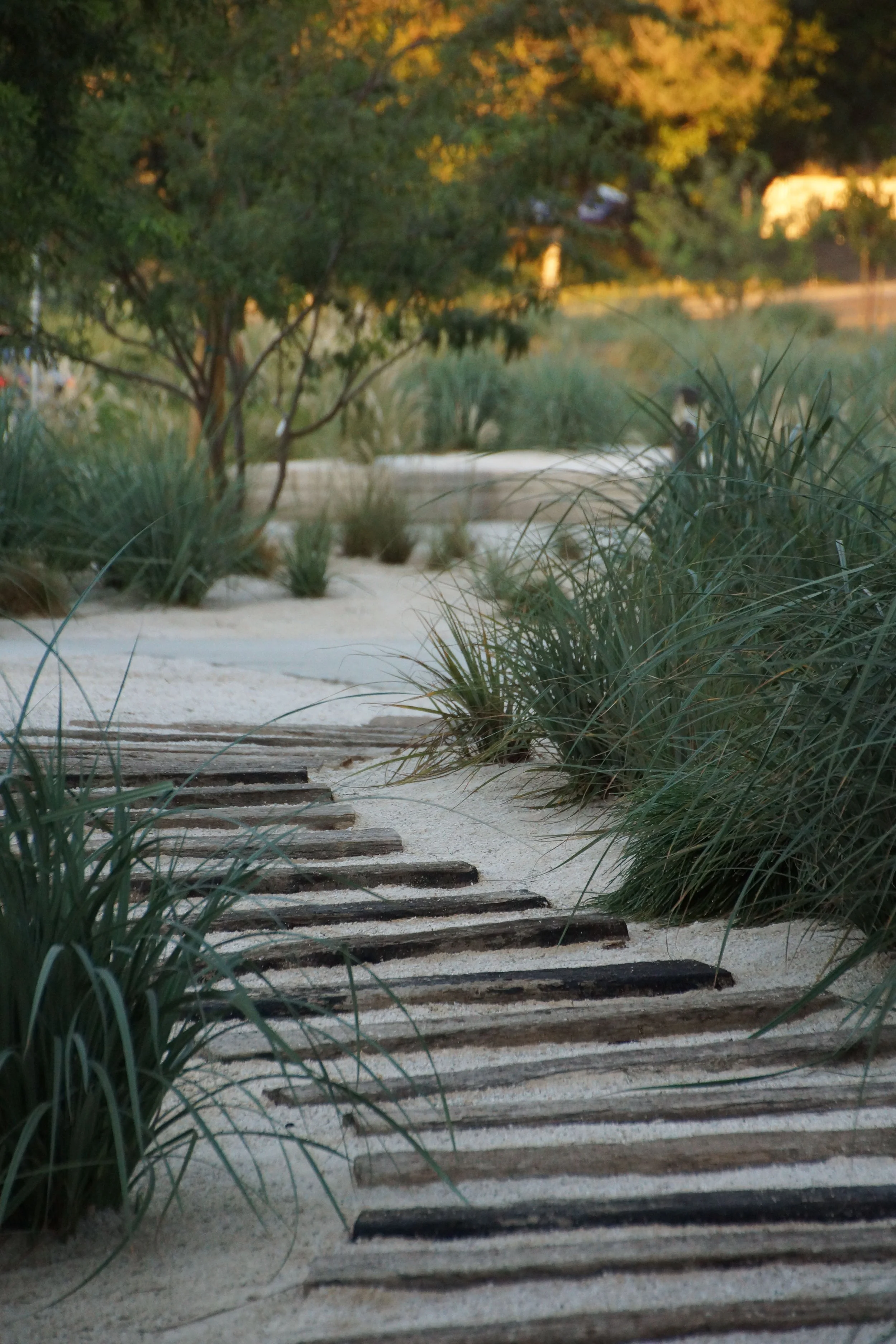Designing Landscapes That Thrive: A Q&A with Kira Becker & Tianchi Zhang
Oberlin Tech, San Diego, CA
At McCullough, sustainability is a philosophy that guides our design decisions, from the first site analysis to the final plantings. To explore how this philosophy comes to life, we sat down with two of our talented Landscape Associates, Kira Becker and Tianchi Zhang, in the Los Angeles office. They shared their insights on crafting landscapes that are not only low-maintenance but full of life, color, and purpose.
Q: How do you approach designing landscapes that are both sustainable and require minimal maintenance?
Kira: “I start by looking at what’s already there and considering what can remain and what can be repurposed in any way. For instance, if we have to remove trees, I’m always looking for opportunities to repurpose them on site to fulfill lumber requirements for the new design such as benches, trellises, decorative elements, etc. Even concrete or old hardscape materials can be reused in creative ways. Very early on in the project I try to determine how we can work with what’s existing on site whether it’s to keep it in place or repurpose it in a creative way, and then get the client involved and excited about it.”
Tianchi Zhang, MLA, ASLA Associate, Los Angeles Office
Tianchi: “Exactly. Sometimes repurposing materials adds cost upfront, but it can save money long-term. Also, if a tree is to be removed, it can be turned into mulch or wood chips reduces future purchases. We will need to consider the health of the trees — an arborist can help determine if a trunk is safe to reuse. And to be sustainable and low-maintenance, it’s not just materials; plant selection, soil management, and irrigation all factor in. Choosing low-maintenance and drought-tolerant plants helps reduce ongoing care. And working with existing soil on site to keep the cut and fill as balanced as possible is another approach to be economically sustainable. Sustainability is really about looking at every detail, from demo to maintenance, and finding creative, practical solutions.”
Q: What native plants or materials work best in Los Angeles’ climate?
Tianchi: “It really depends on the project and the client. Not every native plant thrives in every part of California. Some low-maintenance species aren’t strictly native but perform better in certain microclimates. It’s a balancing act between ecological integrity and practical performance.”
Kira: “Like Tianchi mentioned, just because a plant is “California native” doesn’t necessarily mean it is native to the particular area and microclimate that you’re working in. I often will consult with the CalScape website to determine native plants that are local to the specific area. It provides you with a list of hyper-local species that thrive in a particular zip code. Then I cross-check that list with what nurseries actually carry, so we’re not specifying plants that will be impossible to source. A number of native species are not readily available at plant nurseries, and so it’s critical to determine what’s commonly carried to avoid sourcing issues during installation.”
Top Low-Maintenance Native Plants for Los angeles
California Lilac (Ceanothus) – drought-tolerant, attracts pollinators
Purple Sage (Salvia leucophylla) – low water, aromatic foliage
Toyon (Heteromeles arbutifolia) – evergreen, bird-friendly
California Fuchsia (Epilobium canum) – bright blooms, minimal care
Q: How do you educate or persuade clients about the long-term benefits of sustainable or low-maintenance landscaping?
Kira: “It depends on the client and what sustainability means to them. Sustainability is such a broad term and can mean a million different things. For example, with affordable housing or college campuses, those clients will likely prioritize maintenance costs and durability. Often, the easiest sell is showing how low-maintenance plants and materials reduce ongoing costs. The harder sell is convincing the client to repurpose existing materials or to select environmentally conscious products that might add cost upfront. But when clients do resonate with environmental sustainability, it can become a defining feature of the project.”
Tianchi: “Sometimes it is easy to educate the client about the benefit when it clearly aligns with their short-term saving. However, it can save in a long run in most of the cases – like Kira mentioned, repurposing is slightly more expensive upfront, but it is often cost-effective compared to new materials. In addition, shade coverage, smart plant selection, and reflective hardscape materials all contribute to sustainable, cost-effective landscapes. Ultimately, sustainability is a broad topic — it encompasses ecology, water use, long-term maintenance, and even the joy people experience in a space.”
Talking Sustainability with Clients
Show cost savings over time for low-maintenance plants.
Highlight repurposed materials and environmental impact.
Provide examples of shade and comfort benefits, not just aesthetics.
Q: How do you approach sustainability in materials and products beyond plants?
Kira: “We try to select vendors and products that reflect sustainable practices. For example, we’ve worked with a number of vendors that use recycled plastics in furniture or play structures. We try our best to avoid slow-growing tropical hardwoods that contribute to deforestation, and instead will consider thermally modified wood that’s durable and sourced responsibly or even repurposed lumber as decking from companies like Angel City Lumber or San Diego Urban Timber. There are many layers to a design, and every choice, from concept design to construction, can be an opportunity to make the project more sustainable.”
Tianchi: “Yes, and sometimes the simplest interventions are the most sustainable. Enhancing what’s already there, rather than demolishing everything, reduces emissions and increase resource use. Sustainability can be embedded in every layer of the design, from big concepts to small details.”
Q: What future trends do you see in sustainable landscape architecture for urban environments, specifically Los Angeles?
Tianchi: “One trend, that is happening right now in the educational marketing sector, is engaging the users of a space, like students on a campus, to inform design. For example, shade trees and flexible green spaces are increasingly prioritized because people actually want and use them. Besides, educational projects in several school disctricts are becoming more open to alternative materials, giving designers more freedom to create greener spaces.”
Kira: “I see a shift toward circular design that prioritizes recycling and repurposing of existing materials. Future generations are likely to gravitate towards adaptive reuse over starting from scratch as much as possible. The largest obstacle is the upfront cost, but the long-term environmental benefits are something that I believe future generations will place value on. I predict we are going to start seeing some groundbreaking creativity within the circular economy space in the next 15-20 years.”
Future-Proof Your Landscape
Involve community or users in design decisions.
Prioritize adaptive reuse over demolition.
Choose durable, recyclable materials for long-term sustainability.
Q: Why are you passionate about sustainability?
Tianchi: “I’ve loved the idea of landscape and planning since my first year of undergrad. Designing landscapes is a way to make the world happier and more beautiful. Sustainability lets me extend that impact — creating spaces that endure, thrive, and delight people while respecting natural resources.”
Kira: “For me, sustainability isn’t just about meeting codes or requirements. I personally find meaning in the act of working with what’s there - realizing the value of what already exists, repurposing materials, and minimizing waste. I believe the most sustainable practice is extending the life of materials and spaces through reuse and adaptation, rather than constant demolition and new construction.
At McCullough, sustainable design is a blend of creativity, practicality, and care. Thanks to Kira and Tianchi, and our whole team, our landscapes not only survive, but thrive, delighting the people who use them and respecting the planet we all share.




